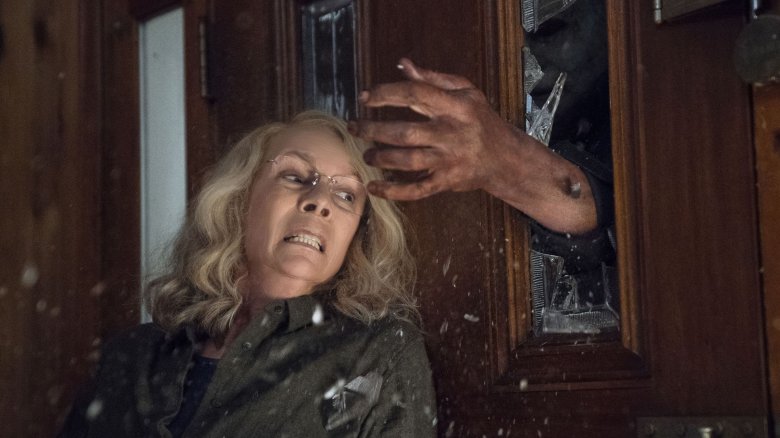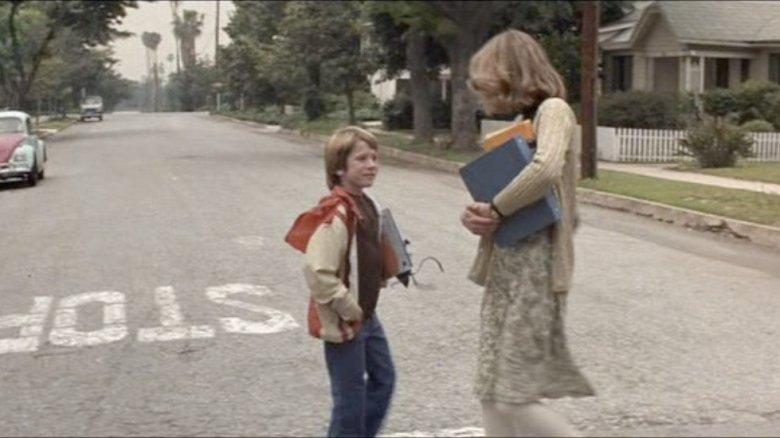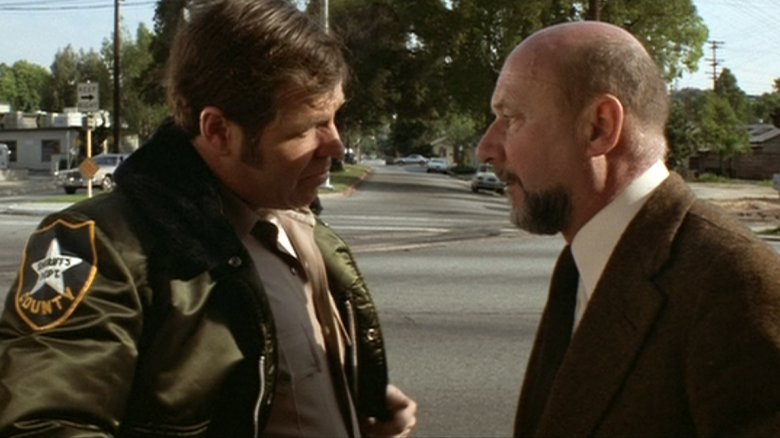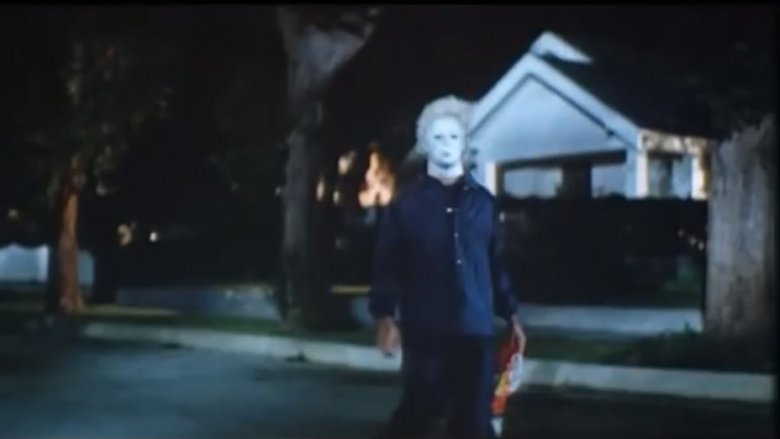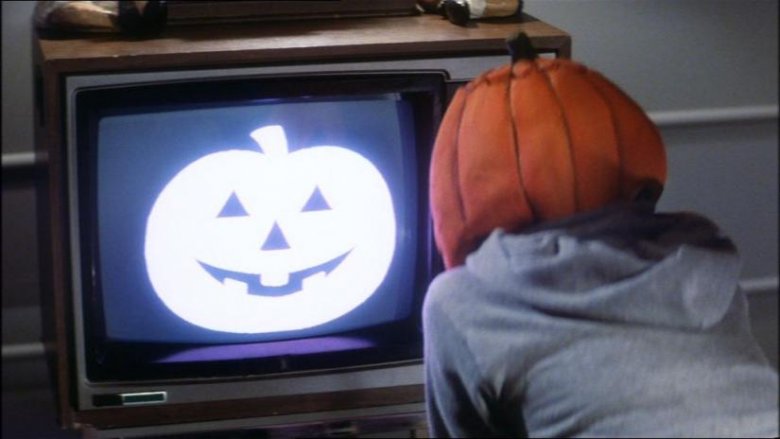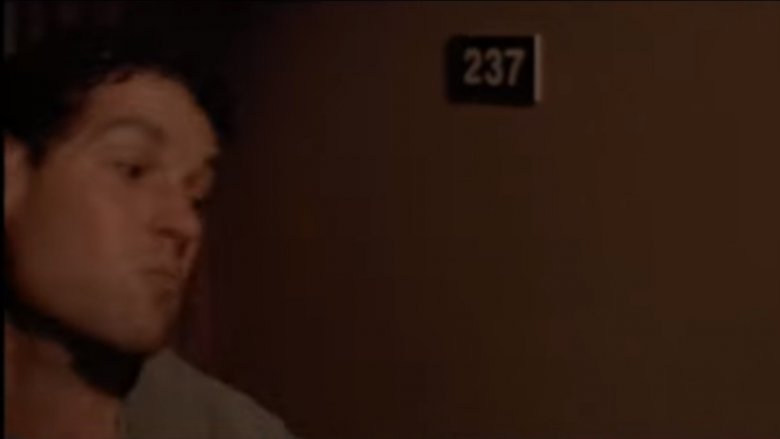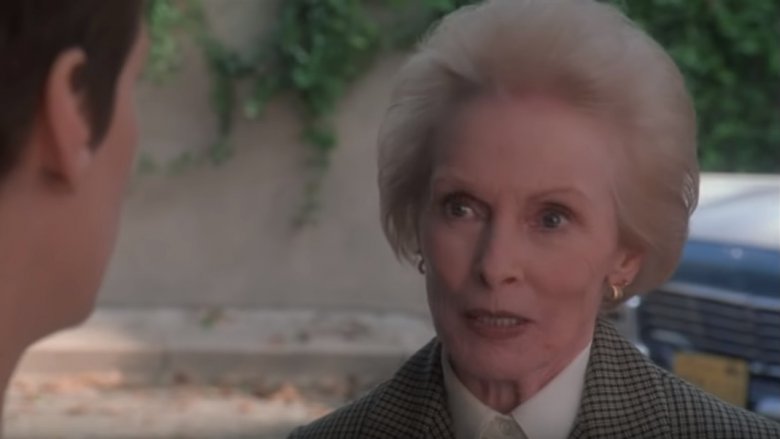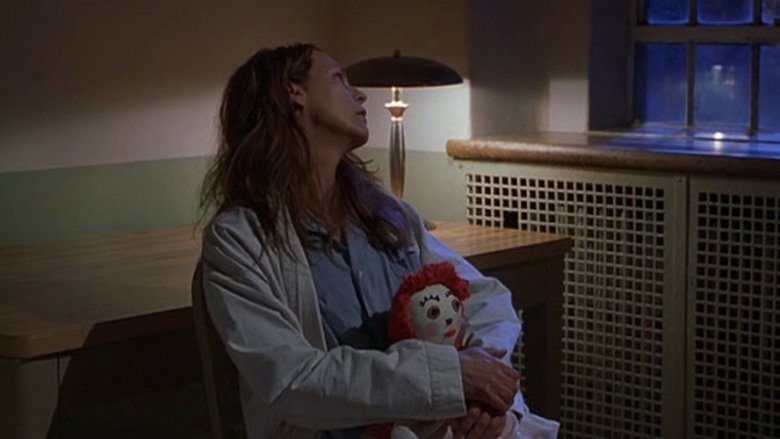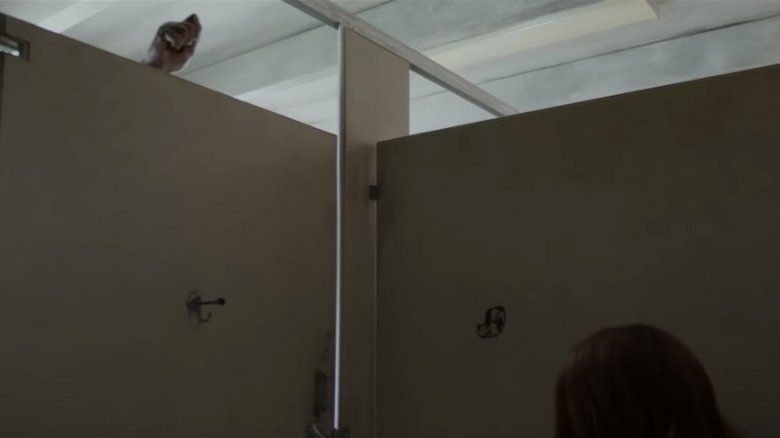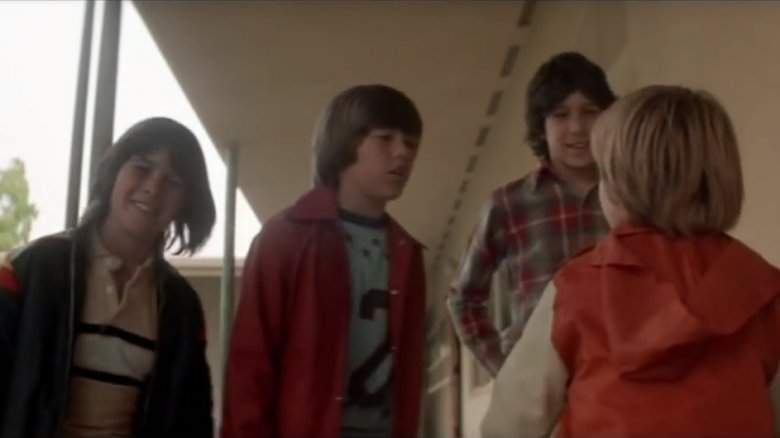Details The Biggest Fans Never Noticed In The 'Halloween' Movies
The world has finally welcomed the long-awaited 11th film in the four-decade-old Halloween franchise. The series began with a low-budget slasher picture about a masked killer terrorizing babysitters, and has since grown into one of the most beloved horror properties ever created. Over the past 40 years, we've gotten multiple attempts at a direct sequel to the original film, a movie that ignored the first entry in the franchise entirely, a trilogy of movies that told a new story with a different set of heroes, and two films in a remake continuity.
That's a lot of stories by a lot of different filmmakers, and along the way, each film managed to add plenty of elements both big and small to the mythos of Michael Myers. We're here to talk about the small stuff, from strange visual quirks to cameo appearances to Easter eggs hidden in the new film that reference the old ones. Even if you're a massive Halloween fan, you may have forgotten (or perhaps never even noticed) these details.
The palm trees of Illinois
The original Halloween film, along with many of its subsequent sequels, is set in Haddonfield, Illinois. That fictional setting was chosen because writers John Carpenter and Debra Hill wanted to create a quiet, seemingly idyllic place that could seem like any pleasant little town in America, then wreak havoc on it with the horror of Michael Myers. So, they made up a town in the Midwest that has since become one of horror cinema's most beloved locales.
In real life, though, the film was shot outside of Los Angeles, which meant Carpenter and his crew had to take certain practical considerations into account to make the locations look as much like the Midwest as possible. This included choosing the right streets, dressing the sidewalks with autumnal leaves that were then gathered back up and stored in bags until the next shot, and framing scenes so that the California palm trees were as invisible as possible. This worked in most of the shots, but not all of them, so careful viewers of Halloween can still find the palm trees of Haddonfield if they look closely enough at the background.
An homage to a cinema legend
John Carpenter, like most directors, was a film lover long before he started making movies, so it's no surprise that Halloween is full of references both big and small to some of his favorite Hollywood icons. Some of these are extremely obvious. For example, while Laurie (Jamie Lee Curtis) and Annie (Nancy Loomis) are babysitting their respective children throughout the night, the kids are shown to be watching both The Thing from Another World (which Carpenter would remake as The Thing just a few years later) and Forbidden Planet.
Another reference to a Hollywood legend is a bit smaller, though. The Sheriff in Haddonfield, who also happens to be Annie's father, is named Leigh Brackett (played by Charles Cyphers). Leigh Brackett is also the name of a legendary Hollywood screenwriter whose credits include The Big Sleep, Rio Bravo, and ultimately The Empire Strikes Back. She was also a prodigious author of science fiction stories and novels, and was the first woman to be shortlisted for a Hugo Award.
The fate of Laurie Strode's crush
Because some of the Halloween movies attempt a very solid throughline of continuity, there are little winks and nods to things that happened previously which very nearly go by unnoticed, but still manage to connect things. Though it was made three years after the original, Halloween II takes place on the same night as the first film, so the filmmakers took steps to keep reminding us of that. This happens in big dramatic ways, such as when Sheriff Brackett learns that his daughter has been murdered, but it also happens in ways that are harder to spot.
At one point in the film, Dr. Loomis (Donald Pleasence) spots a man walking along the streets in a mask that looks very similar to Michael Myers'. Loomis, believing he's found his man, panics and starts shouting at the masked figure, even aiming his gun at him. In the chaos, a police car rams into the man, knocking him into a van which then catches on fire and burns him alive. In the credits of the film, the man is named "Bennett Tramer." In Halloween, Ben Tramer is mentioned as the object of Laurie's crush, leading Annie to try to get Laurie to go to the dance with him the following night. Annie later says that Ben has gone drinking on Halloween night. Now we know his final fate.
The voice of Laurie Strode
By the time Halloween III: Season of the Witch rolled around, the film's producers (including creators John Carpenter and Debra Hill) wanted to try something different. They opted for an anthology format for the franchise, telling different stories still centered around the Halloween holiday, and so a plot was devised about killer Halloween masks and an ancient pagan ritual. That meant no Michael Myers, no Dr. Loomis, and no Laurie Strode, but there would still nods to the franchise's past. The film's famous poster, for example, features the tagline "The night no one comes home," a reference to the line "The night He came home!" on the original poster.
There is also one uncredited but recognizable cameo appearance. Laurie Strode isn't in the movie, but while Jamie Lee Curtis can't be seen in the film, she can be heard. Curtis makes a dual voice cameo as a curfew announcer and as a telephone operator, so she technically played a part in the first three Halloween films before staying out of the franchise until 1998's Halloween H20: 20 Years Later.
A familiar room number
By the time the '90s rolled around, Halloween had become such a fixture in the horror cinema canon that the films began to make knowing winks in the direction of other horror classics. For example, H20 contains references to both Friday the 13th and Scream, but a more subtle reference is lurking in 1995's Halloween: The Curse of Michael Myers. In that film, Kara Strode (Marianne Hagan) is abducted by the Cult of Thorn and taken to the Smith's Grove sanitarium, where Michael was once held.
When Tommy Doyle (Paul Rudd) tries to rescue Kara by breaking down the door of the room where she's imprisoned, it's revealed that the room number is 237. Room 237 is famous among horror fans as the most dangerously haunted room at the Overlook Hotel in Stanley Kubrick's The Shining, based on Stephen King's novel of the same name. It seems horror characters just can't escape those three terrifying numbers.
The mother of all Scream Queens
As the daughter of actor Tony Curtis and actress Janet Leigh, Jamie Lee Curtis was already Hollywood royalty even before she became a star in her own right, but the legacy is a little more complex than just parentage. Halloween is often considered the first true slasher movie to set all the various conventions of the genre, but Alfred Hitchcock's Psycho might be the granddaddy of them all thanks to its themes, plot, and murder sequences.
That film, of course, stars Curtis' mother, who famously dies in Hitchcock's iconic shower sequence. As improbable as it was that the star of a proto-slasher classic would be the mother of the next generation's Scream Queen, it might seem even more improbable that they actually appeared in a slasher movie together. That did eventually happen, though, in Halloween H20: 20 Years Later, when Leigh made a cameo appearance as Norma Watson, the secretary to Keri Tate, which was Laurie Strode's assumed identity in the film.
Laurie Strode's still playing with dolls
Halloween: Resurrection has been disowned by a good many faithful Halloween fans as perhaps the worst installment in the franchise, relying too much on gimmicks to inspire any real scares. Until the 2018 film rendered it non-canonical, though, it was the last appearance of Laurie Strode in the series timeline, as Jamie Lee Curtis returned once more to play a version of Laurie who'd been confined to a mental institution after the events of H20.
In truth, Laurie is simply biding her time, pretending to be over-medicated and detached while she waits for Michael to eventually find her again. When he does, fans might notice a particular souvenir sitting in Laurie's room: a Raggedy Ann doll. The doll never had a big role to play in the series, but if you watch Halloween closely, you can see that the doll is present in Laurie's childhood bedroom, signifying that she's still holding on to what she was before that fateful night, if only a little bit.
The Mark of Thorn lives on
Halloween: The Curse of Michael Myers attempted to provide some proper mythological explanation for why Michael continued to stalk and attempt to kill members of his own family. That film established that he'd been affected by the Mark of Thorn, an ancient Druid curse that compelled people to murder their next of kin as a sacrifice on the pagan festival of Samhain (a tradition that evolved into Halloween in modern culture). The explanation obviously didn't stick, but some fans of Thorn are still fond of the attempt, and of the weird rune that appeared as a tattoo on Michael's wrist in that film.
In 2018's Halloween, the mark makes a very brief but noticeable return, as long as you're looking for it. When Michael stops at the gas station to stalk and kill a pair of podcasters, we see the inside of a bathroom stall with a piece of graffiti on the wall that, at first glance, looks like it might just be a drawing of a roll of toilet paper unspooling. Upon closer inspection, though, there is a triangle sticking up from the horizontal line at the bottom of the drawing. Together, the line and the triangle seem to form the Mark of Thorn.
The Elam family is still a problem
Halloween returned again to Haddonfield for the 2018 entry in the series, and there are numerous character connections to that Halloween night 40 years earlier. For example, the current sheriff in town (Will Patton) was one of the officers who arrested Michael Myers back in 1978. Another connection emerges when Allyson (Andi Matichak) invites her boyfriend Cameron (Dylan Arnold) to have dinner with her parents.
Over that dinner, it becomes clear that Allyson's father Ray (Toby Huss) used to hang out and get in trouble with Cameron's father, Lonnie Elam. Lonnie Elam is one of the boys who bullies young Tommy Doyle in the original film, telling him the Boogeyman is going to get him. As a result, Laurie famously tells Tommy that Lonnie "probably won't get out of the sixth grade." Well, Lonnie eventually got far enough to have a son, and that son has carried over a little bit of the family selfishness, as he turns out to not be a very good boyfriend at all.
